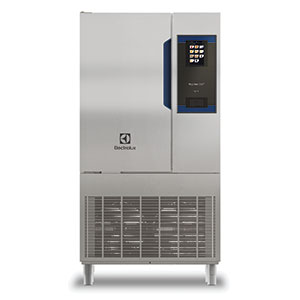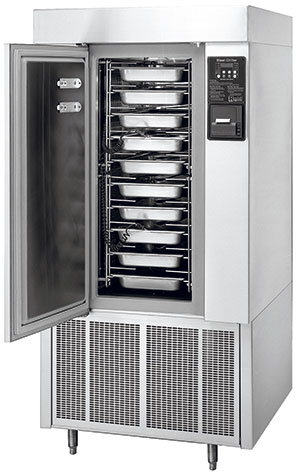When purchasing a blast chiller, operators need to first determine food volume before choosing which size unit is appropriate. Blast chillers are sized by the number of pounds that can be accommodated at one time. Units typically use 2-inch-deep pans that hold about 10 pounds of product.
Blast chillers remove the heat from food, bringing temperatures down from 160 degrees F to 38 degrees F in 90 minutes or less. This process reduces the possibility of bacterial growth.
Refrigeration, such as walk-ins and reach-ins, holds ingredients cold and at food-safe temperatures until operators need to serve the food or assemble menu items. In contrast, blast chillers remove heat from food items, bringing them down to safe temperatures.
The average service life of a blast chiller can vary, depending on use, environment and various other factors but most last between 5 and 10 years. Unlike refrigeration equipment, blast chillers are not designed for continuous operation and should be shut off when not in use.
One of the biggest issues with blast chillers is that operators commonly underestimate these units’ complexity. Fortunately, with newer technology and control boards, these units have become easier to use than in the past. Still, chilling product in blast chillers is much different than simply placing food in a refrigeration unit. There needs to be an educational component for those working with this equipment about how food should be sized, shaped and packaged prior to the chilling process for optimum results and to ensure adherence to proper food safety protocol.
Featured Products
-

SkyLine Chill Blast Chiller-Freezer 102
Electrolux Professional
This blast chiller can take 220 pounds of food from 195 degrees F to 37 degrees F in less than 90 minutes, according to the maker. Features include a high-resolution, touch-screen interface that translates into more than 30 languages; a cooling fan that operates at 7 different speeds and timer that can manage up to 20 different cooking cycles. The fan stops within five seconds of the door opening.
-

Randell BC Series Blast Chillers
Unified Brands
Randell BC Series Blast Chillers have touch-screen controls and an auto-launch cooling feature. A color-coded probe identification system ensures proper probe placement. Reach-in, work-top and undercounter models are available. The three models come standard with a front-mounted USB port for retrieving recorded data for HACCP program documentation.
Related Articles
-
What to Consider When Specifying Reach-Ins
Read FeatureThe confluence of high labor costs and consumers’ need for speed creates a recipe for accessible, portable food options, either as the main meal or as add-on items. As a result, the role of the reach-in continues to evolve from simple storage item to profit center for many foodservice operators, including fast-casual and quick-service operators.
-
What to Consider When Purchasing Undercounter Refrigeration
Read FeatureUndercounter and underbar refrigeration serve as supplemental storage solutions for the front of house or in the kitchen as part of a prep station. Timothy A. Barker, founder of Table & Bar Consulting Group in Memphis, Tenn., provides information on what to consider when purchasing undercounter refrigeration.











